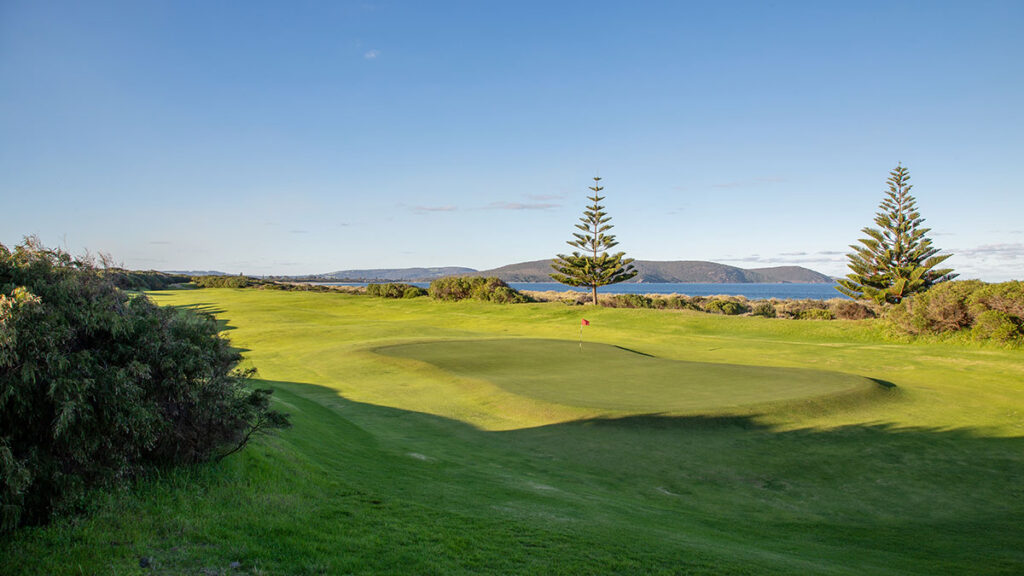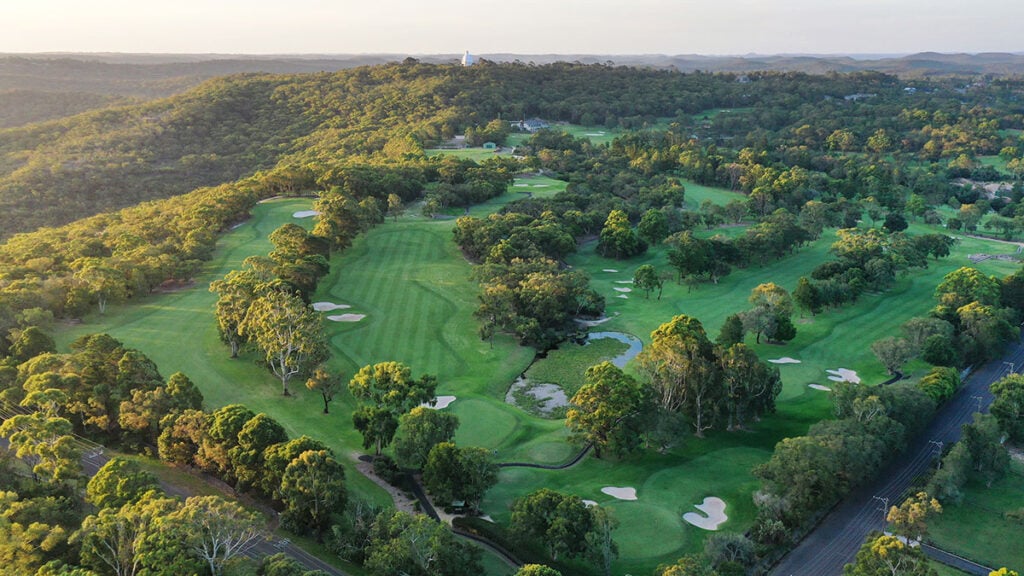THE RAILWAY at Royal Colombo Golf Club, Sri Lanka
Established in 1880, the Royal Colombo Golf Club is the oldest golf club in Sri Lanka and one of the oldest outside the United Kingdom. It has as many as 3,000 members and is the only course in the capital city. Holes are tightly compacted into approximately 38 hectares (96 acres) of land in the middle of the city and the course is an oasis for some remarkable fauna, flora and man-made features.
The most remarkable feature is the active railway line that divides most of the holes on the front nine. Golfers must navigate their way over, around or alongside this unconventional feature while on the lookout for passing trains (which are as frequent as every 20 minutes). The railway line adds immeasurable interest and gives the course great character.

ROADS & OBSTACLES at Nuwara Eliya Golf Club, Sri Lanka
The town of Nuwara Eliya is situated nearly 2,000 metres above sea level in the heart of Sri Lanka’s tea country. Tea plantations dominate the surrounds but the focal point of the town itself is the Nuwara Eliya Golf Club that was formed in 1889 by British planters looking to create a golf course that would provide rest and recreation.
The 18-hole course is one of the most unique in all of Asia with holes bobbling up and down the landscape like a roller coaster with little respect for rules or regulations. In fact, crossing holes are the norm, blind shots are frequent and roads and fences need to be traversed on route to the hole.
The fourth is a great example of what to expect at Nuwara Eliya. The tee shot is played from an elevated site over the public highway, over the 11th green, over the public pathway and onto a common area. The second shot is played to a raised green complex nestled in the heart of the town centre and framed by large buildings.

THE TOMBS at Delhi Golf Club, India
The Delhi Golf Club is a 27-hole facility that is regarded as India’s most prestigious golf club. The 18-hole Lodhi course is a strong test of golf that has played host to numerous Indian Open championships while the nine-hole Peacock course offers a much shorter but no less exacting challenge.
The 90-hectare site is characterised by gentle rolls, thick bush and abundant birdlife. (Hundreds of peacocks wonder the fairways and through the rough.) Both courses are laid out over a vast burial ground of Moghul nobles. Nearly 100 tomb sites dot the property with many in clear sight and some in touching distance of tees and greens. These architectural structures beautify the two courses and create a real sense of belonging.

CLUBHOUSE/HOMESTEADS at Carey Island Sports Club, Malaysia
Carey Island Sports Club was built in the late-1920s for the local band of Europeans living on Carey Island – one hour’s drive from the hustle and bustle of Kuala Lumpur. The arrival is impressive, including the very quaint and distinct clubhouse with views out over the course. Very little has changed since its exception other than the addition of a further nine holes a few years ago.
The original nine holes are possibly the quirkiest in all of Malaysia. Golfers need to use their imagination and creativity to avoid the multitude of obstacles – some conventional like trees and bunkers and others not so conventional like fences, roads and homesteads. The old homesteads provide much of its charm and highlight what it must have been like on the island back when the golf course was originally built.

THE PAGODAS at Bagan Golf Club, Myanmar
Golf was established in Myanmar in 1887 when commander of the 11th Bengali infantry, Colonel Sinfos, and military engineer Richard Barwell planned a golf course in the town of Thayet for the health and recreation of British forces. Since then golf has grown exponentially with nearly 130 courses spread across the entirety of Myanmar.
The town of Bagan, five hour’s drive north of Thayet, is one of the most remarkable places on the globe with up to 3,000 pagodas nestled in the surrounding area. The Bagan Golf Club has 14 pagodas on the course property. Built between 9-11AD, these remarkable structures are visually stunning. Thankfully, the course is not overly endowed with standard golf features and this allows an opportunity to appreciate the splendour of the pagodas.

THE MONASTERY at Popa Golf Club, Myanmar
There is no shortage of distinct and original courses in Myanmar. One such example is Popa Golf Club, a nine-hole layout at the foot of Mount Popa, an extinct volcano. The local community manages the golf course, which is used for other recreational purposes as well as a vehicle thoroughfare.
The course is as varied as you will find. Hazards include roads, gullies, trees, bunkers, roads, fences, rocks and cattle. Cows roam freely throughout the course and provide a substitute for maintenance equipment (given the golf club has only one mowing machine).
The most impressive feature – and perhaps the most impressive backdrop in Asian golf – is the Popa Taungkalat Monastery that sits high on the hillside. The Buddhist monastery is accessible only via a stairway consisting of 777 steps. It stands proud in the distance and dominates the skyline from just about every hole at Popa Golf Club.

BRIDGES at Yemon Island Golf Resort, Myanmar
It’s not often you would classify a bridge as a unique golf course feature. But the bridges – and crossing experience – are truly memorable and daunting at Yemon Island Golf Resort. About an hour’s drive from the city of Yangon, Yemon Island is routed alongside a large water body that comes into play frequently throughout the round. The water is such a prominent feature that, when the golf course was first built, the only way to get to certain sections of the golf course was by boat. Given this took a considerable amount of time, the golf club invested in numerous bridges to ease the time burden.
Some of the bridges are 200 metres long. But what sets them apart is the crossing experience. When traversing these structures it’s imperative to walk along the centre and avoid looking down. Each wooden plank is divided by a gap with water in full view below. To heighten the anxiety, the bridges creak constantly and swing from side to side.
In addition, square greens, tees and bunkers make Yemon Island one of the most unique courses in all of Asia. At $5 a round of golf, it’s well worth a visit – even if just for the bridge experience.

THE RACETRACK at Royal Bangkok Sports Club, Thailand
The Royal Bangkok Sports Club could best be described as an obstacle course. Golfers have to contend with a myriad of unconventional features that come into play – such as a cricket pitch/driving range/hockey field, tennis courts and even a racetrack.
The routing itself is very creative given the course comprises less than 36 hectares with no opportunity to expand. The racetrack is the most prominent feature and is constantly in play from the tee or approaching the green. The course is open on race days and it’s common practice for spectators to bet on the golf and even cheer a good shot.
Royal Bangkok Sports Club is a wonderful use of green space and could be the best multi-use facility anywhere in the world. Where else could you enjoy just about every sport imaginable on less than 40 hectares? And where else would you find 18 more original holes?

THE CREVASSES at Red Mountain Golf Club, Thailand
The island of Phuket is a popular holiday destination for beach, sun and golf. There are eight golf courses on the island including the Red Mountain Golf Club, which is carved through an old tin mine. The landscape at Red Mountain is dramatic with extreme elevation changes and some rather unusual features that dictate the line of play and create great interest. The architect incorporated many of these existing site features into the design.
The short third hole is an example of the dramatic property. Carved through the jungle, the tee shot is played over an unusual landform that could best be described as a crevasse (minus the ice). The existing vegetation has been removed to expose these impressive formations. In an era where golfers are fed a plethora of similar features, it’s refreshing to play a course with an abundance of distinctive features.

THE GUN SHELTER at BRG Da Nang Golf Club, Vietnam
The BRG Da Nang Golf Club is one of the best courses in Asia with a host of fun and engaging golf holes that merge wonderfully into their surrounds. The course is also a wonderful journey of discovery given that Da Nang saw some of the most intensive fighting during the Vietnam War.
Some holes at Da Nang Golf Club were routed to take advantage of historical links to the war. The walk from the 16th green to the 17th tee takes you past an old gun shelter, which highlights an unsavoury period not so long ago. Some may see this as an unwelcome reminder. Yet remove it and the sense of history would be lost.

THE RICE PADDY FIELDS at Laguna Lang Co, Vietnam
Nestled between mountains and ocean an hour’s drive from the cities of Hue and Da Nang on Vietnam’s central coast, the Laguna Lang Co resort is a luxurious facility that includes a Banyan Tree and Angsana hotel as well as a very distinctive and sustainable 18-hole course. The layout has great variety and traverses a multitude of different environments, including jungle, beach, rock and rice paddy fields.
Four holes on the course are flanked by rice paddy fields. Brought into existence during construction, the fields produce up to 30 tons of rice a year. These fields not only influence play from a visual and strategic perspective, but they provide golfers with a kindly reminder of the remarkable environment in this part of the world. In that regard, they give the course an identity and a sense of place
About Paul Jansen
Paul Jansen is widely regarded as one of golf’s most well travelled course architects. After having schooled in South Africa, he began his career in America before relocating to Europe where he worked for Nick Faldo Design on a variety of projects in Europe, Africa and South East Asia. In 2011, he established Jansen Golf Design & Construction with a focus on creating highly sustainable golf courses that provide strategic, stimulating and memorable golf.




